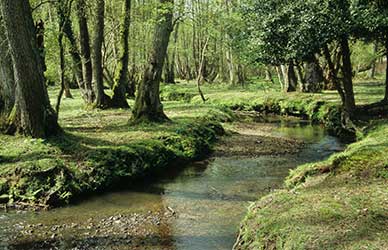Alder woodlands

Dense, often impenetrable alder carrs have developed alongside many of the New Forest streams where the adjacent ground is waterlogged for much of the year. Here alder is the dominant tree as no others tolerate the wet conditions.
Reasonably readily recognised, alder trunks are usually tall, straight and slender. Alder bark is dark brown, and rough, whilst the leaves are dark green and rounded. But should there be any doubt about identification, the presence of cones is absolutely diagnostic – amongst broad-leaved trees, only the alder possesses them.
The alder is also the only native tree that grows well in waterlogged conditions, a feat made possible by the presence of bacteria in the alder’s root nodules. The bacteria extract nitrogen from the air, and ‘fix it’ for use by the tree, making up for chronic shortages in waterlogged soil of this colourless gas so essential for life.
Many alders in New Forest alder carrs exhibit multiple trunks growing from ground level, or just above, for this indicates that they have been coppiced, that is, repeatedly cut to promote the growth of shoots that could be harvested again and again after every cut.
Those doing the cutting, though, were forced to disregard an age-old superstition that alders are trees of evil, a belief that came about because cut alders take on an orange-red tinge, as if bleeding.
The water-resistant nature of the wood encouraged use in water pipes, wooden pumps, and for piles under bridges and buildings. Alder also burns slowly and provides one of the best charcoals for use in gunpowder manufacture, whilst latterly, charcoal from these alders was used extensively in gas mask filter manufacture.
Notice, too, amongst these alders, examples that stand as if on stilts, the central, lower portion of their trunks no longer present, a feature presumably created by erosion following repeated flooding of the ground in which they grow.
Look and listen also for brightly coloured siskins and duller redpolls. Tiny finches characteristic of alder woodlands, both can often be seen and heard as they flit from tree to tree, feasting on the seed harvest deep within the tiny, darkened cones, brightening the water-side with their contrasting, distinctive songs and calls.
But beware when entering an alder carr. Although many of the streams have been modified by man in attempts to improve the drainage, the ground below the trees is often very wet and sometimes swampy, and walkers are best advised to use only recognised pathways.
References:
The Living Countryside: Britain’s Alder Woodland
The Englishman’s Flora: Geoffrey Grigson
The New Forest – A Natural History: Colin R. Tubbs
More links
Other related links
Search this site

Sadly, 58 animals were killed - 35 ponies, 13 cows, 8 donkeys and 2 sheep, whilst a further 32 were injured - 3 pigs, 9 donkeys, 11 cows and 9 ponies.
(Forty-three accidents occurred in daylight, 15 at twilight and 101 in the dark. Twenty-seven accidents were not reported by the driver involved).
Here's just one horrific example - Three donkeys killed in collision with van at notorious New Forest blackspot (Advertiser and Times)

